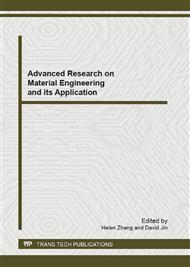p.369
p.373
p.377
p.381
p.385
p.389
p.393
p.399
p.403
Studies on Adhesion of Nitzschia closterium and Chlorella vulgaris to 316L Stainless Steel
Abstract:
Microalgae can cause damages to the marine engineering material by adhering to the surface of the material. In this study the adhesion of Nitzschia closterium (bacillariophyceae) and Chlorella vulgaris (chlorophyceae) to 316L stainless steel were investigated. The influences of surface roughness and culture pH value on adhesion were performed. The results showed that the adhesion of N. closterium increased significantly with the increasing roughness (F = 17; p < 0.001). And both species of algae were prone to adhesion to 316L stainless steel immerged in alkalescent medium. Impedimetric method was applied to analyze the process of microalgal adhesion on the surface of stainless steel. A kinetic model (Y = A + Be-t/C) based on the sensitive variation of double layer capacitance (Cdl) of the electrode abstracted from impedance spectroscopy using equivalent circuit was developed for the algal adhesion.
Info:
Periodical:
Pages:
385-388
Citation:
Online since:
February 2012
Authors:
Price:
Сopyright:
© 2012 Trans Tech Publications Ltd. All Rights Reserved
Share:
Citation:


